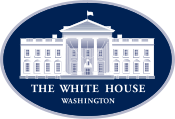White House Office of Presidential Correspondence
The Office of Presidential Correspondence is one of the largest and oldest offices in the White House,[1] and is a component of the Office of the White House Staff Secretary.
Function
Presidential Correspondence is responsible for dealing with all mail, email, and parcels addressed to the President of the United States. The office mission is to listen to the writers' views, experiences, and ideas and coordinate an appropriate response on behalf of the White House.
In addition to mail and email, the office is responsible for:[2][3]
- answering phone calls to the White House Comment Line
- processing gifts intended for the First Family or White House staff
- answering requests for official proclamations, messages for special events, and acknowledgements for individual milestones
- and tasking constituent casework to federal agencies.
History
The Office of Correspondence formed over the fifty-year White House career of staffer Ira R.T. Smith. Mr. Smith began handling the mail as a part of his duties as a clerk to President William McKinley in 1897. At the time, Mr. Smith was one of only twelve White House staffers.
President McKinley received about 100 letters per day. That grew to about 800 per day under President Herbert Hoover, and ballooned to about 8,000 per day during President Roosevelt's New Deal. The staff expanded to meet the increased need and Mr. Smith was named the first "Chief of Mails" (now Director of Correspondence). Mr. Smith ran the office until his retirement in 1948.[4]
From the Eisenhower through the Nixon Administration, the chief of the Presidential Correspondence division was an officer selected from the US Foreign Service, a tradition attributed to the corps' reputation for superior drafting skills. The last Foreign Service Officer to serve as Chief of Correspondence was Michael B. Smith, from 1971-1973, who was succeeded by a political appointee.[5]
In the Carter Administration, Correspondence was moved into the newly-created Office of Administration. The modern Office of Presidential Correspondence was created when the Reagan Administration split the correspondence analysis and response tasks away from the mail logistics tasks. Mail logistics remained with the Office of Administration, and the Office of Correspondence was re-established in the Office of the Staff Secretary to handle the more political tasks of analysis and processing.
During the Presidency of Bill Clinton, the Office annually prepared over 6,000 custom letters, messages and proclamations.[6]
As of the first year of the Obama Administration the White House was receiving tens of thousands of letters, parcels, and emails per day.[7]
Presidential Correspondence has played a more visible role in the Presidency of Barack Obama due to his request to receive a representative sample of ten letters from the public every day.[7] President Obama's senior aides have acknowledged that the letters play an important role in informing the President's perceptions of how policies are impacting ordinary people. The most noteworthy example of this is probably the case of Natoma Canfield, who wrote to the President in December 2009 detailing her struggles against leukemia after losing her health insurance. In March 2010, the letter became a centerpiece of the White House effort to pass the Patient Protection and Affordable Care Act through Congress.[8] After the passage of the law, her letter was framed and hung on the wall outside the President's private office.[9]
References
- ↑ "2014 Annual Report to Congress on White House Staff". WhiteHouse.gov. 2014-07-01. Retrieved November 7, 2014.
- ↑ "Presidential Department Descriptions". WhiteHouse.gov. Retrieved November 7, 2014.
- ↑ An Insider's Guide to Political Jobs in Washington (ISBN 0471268194)
- ↑ Smith, Ira (1949). Dear Mr. President. Messner. ISBN 1406762024. Retrieved November 18, 2014.
- ↑ Association for Diplomatic Studies and Training: Oral History Interview With Michael B. Smith, p. 49.
- ↑ Inside the White House: Sincerely, Bill Clinton - Presidential Correspondence Today
- 1 2 Parker, Ashley (2009-04-19). "Picking Letters, 10 a Day, That Reach Obama". The New York Times. Retrieved November 7, 2014.
- ↑ Saslow, Eli. Ten Letters: The Stories Americans Tell Their President. Random House. p. 91.
- ↑ Schulman, Kori (2012-06-28). "Natoma Canfield's Letter to President Obama". WhiteHouse.gov. Retrieved November 7, 2014.
